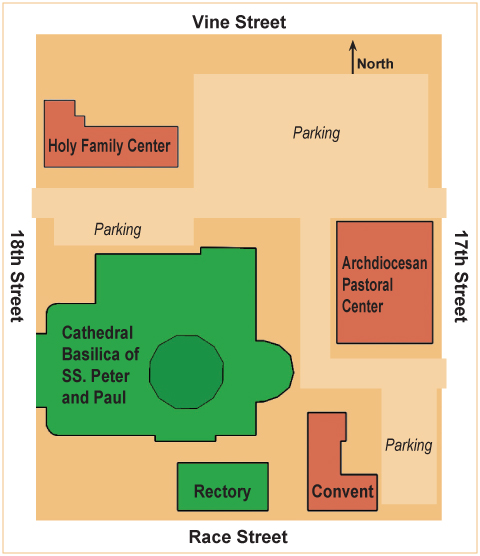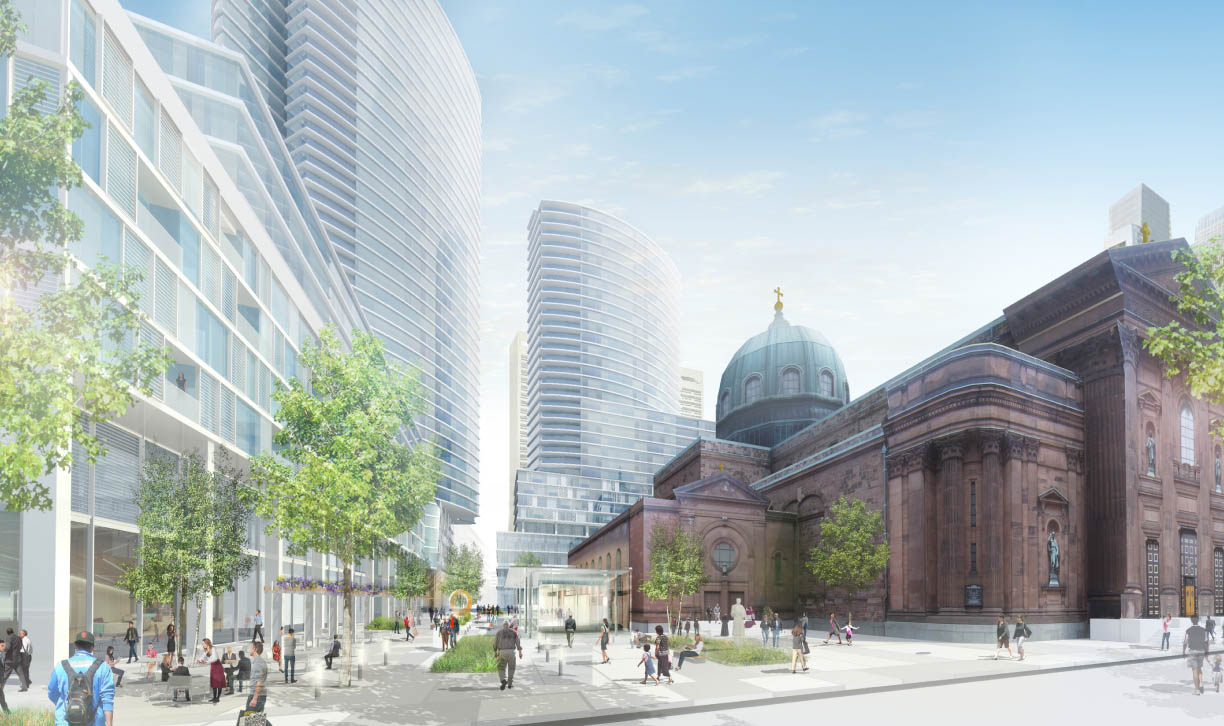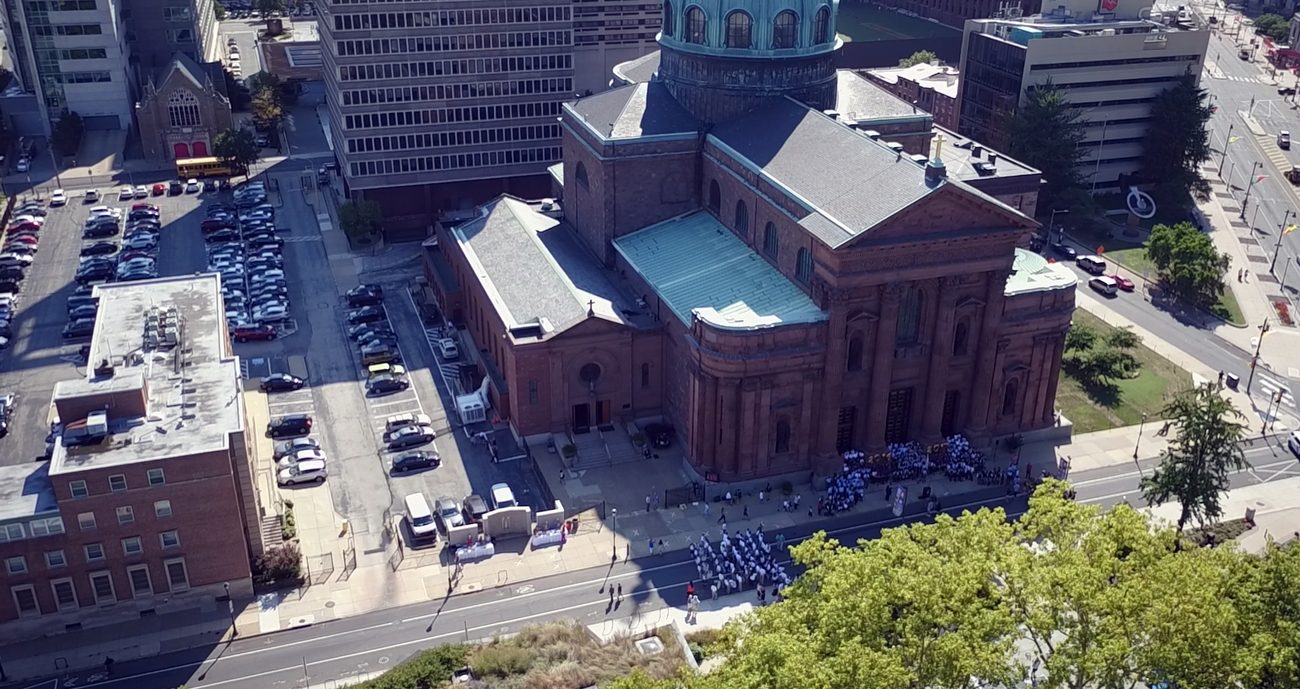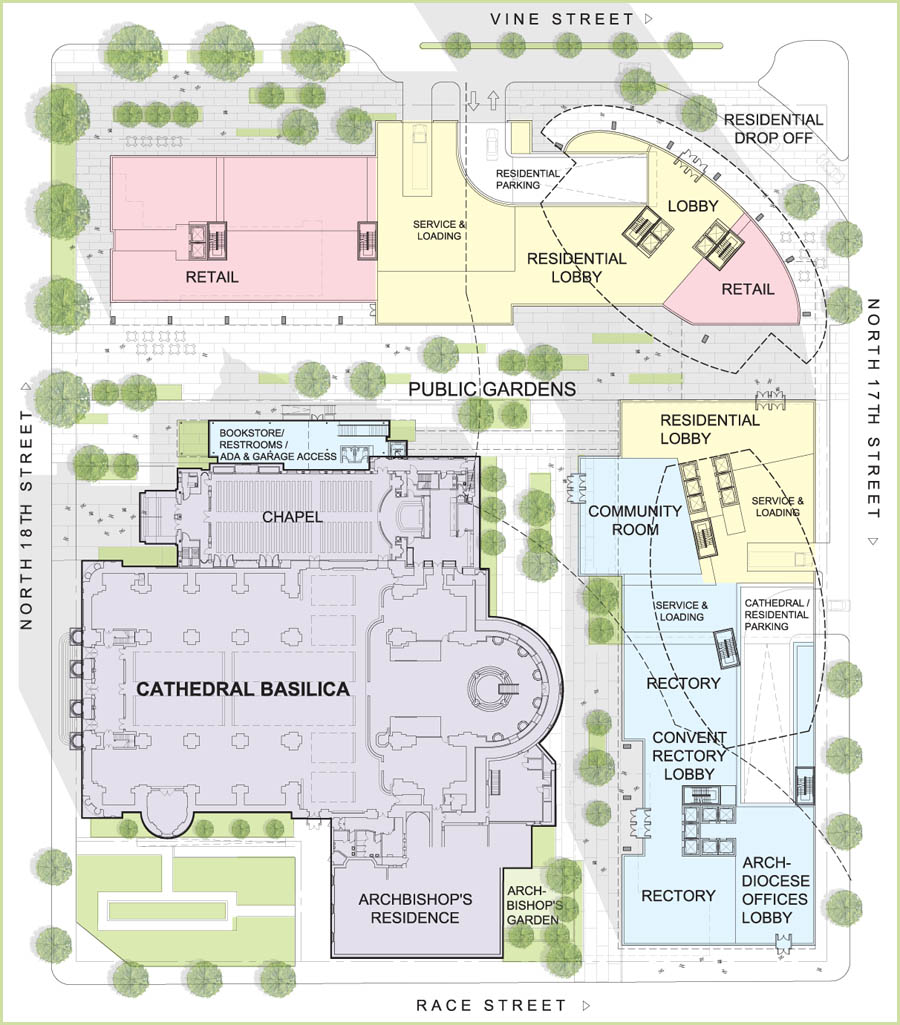
The block features a 200-car parking lot, archdiocesan office buildings, the cathedral, a rectory and convent. (Graphic by Barbara Hagan)
Officials and planners representing the Archdiocese of Philadelphia met with officers and members of the Logan Square Neighborhood Association on Monday evening, Oct. 24 at the Archdiocesan Pastoral Center to share a conceptual plan for the redevelopment of the complex of buildings surrounding the Cathedral Basilica of SS. Peter and Paul.
Interestingly, part of the plan is the demolition of the building at 222 North 17th Street where the meeting was held.
But the emphasis was conceptual — at this point nothing is set in stone (or steel and glass).
Representing the archdiocese at the meeting were Father Dennis Gill, rector of the cathedral; James Bock, secretary for temporal services; Deacon Thomas Croke, director of property and real estate services; attorney Hercules W. Grigos of Obermeyer Rebman, Maxwell & Hippel and architect Antonio Fiol-Silva, who explained the plan.
As it was noted by way of background, the cathedral complex traces back to 1838 when the first lot was purchased by Bishop Francis Kenrick as a site for St. Charles Borromeo Seminary.
At that time Vine Street was the northern border of the City of Philadelphia and the area was sparsely populated. It surprised many when shortly after, in 1846, Bishop Kenrick decided to build his cathedral and residence there also.
The seminary moved to Wynnewood many years ago, but the cathedral remains along with other archdiocesan buildings in an area where real estate is currently booming. What makes the property especially attractive for development is the 200-car surface parking lot, which is an unusual but hardly attractive luxury at a time when the archdiocese needs to better monetize its assets to support its ministries.
A few years ago there was a plan to sell part of the parking lot but the prospective buyer and the archdiocese could not come to agreement on how the land would be used. “They didn’t understand our programmatic needs,” Deacon Croke said.
From the beginning of Monday night’s meeting it was clear the cathedral would not be sold, and nothing would be done to diminish its dignity.
Other challenges facing a development plan are building height restrictions of the Benjamin Franklin Parkway zone, zoning restrictions and the need to present a plan that would be acceptable to the neighborhood association.
The plan as discussed is certainly imaginative and attractive. In addition to the cathedral and the adjoining chapel that would remain, the three-story brownstone rectory would be converted into a residence and offices for the Archbishop of Philadelphia.
The three-story convent and four-story Holy Family Center would be razed as would the 13-story office building, which is deemed extremely inefficient with respect to maintenance and utility costs, and too expensive to update. A new smaller rectory for priests serving the cathedral parish would be built, along with meeting space.
Two multi-use towers, oval shaped in the conceptual plan, would be built further back on the complex so as to comply with the height restriction for the parkway. The lower levels could be commercial, with the upper stories residential.
[hotblock2]
One tower in the plan was 33 stories or 360 feet high, the other 44 stories or 455 feet high, but a plan could also envision a single building with a larger footprint.
Under this plan some of the present staff in the Archdiocesan Pastoral Building would relocate to one of the towers, while other workers would go to different diocesan locations.
A key component for the whole plan is relocating the parking lot underground, with room for 400 vehicles to serve the needs of the cathedral, the archdiocesan staff and apartment residents in the towers. This is especially of concern to the members of the neighborhood association who are wary of any development that does not include ample parking.
Also as conceived without the surface parking lot, there is ample room for gardens and other green public areas to make the complex more pleasing and walkable.
Again, all of this is conceptual. At this point the key is obtaining a developer who is willing to undertake and finance the project.
The plan at this time is not an outright sale of the property to the developer. It would be a long-term land lease, perhaps 99 years, with an initial large payment and smaller annual payments thereafter.
But there will be further give and take between the archdiocese, the eventual developer, the neighborhood association and appropriate municipal agencies before anything happens, and by that time the final project may be quite different than the conceptual plan.
Whatever the outcome, nothing will be agreed upon by the archdiocese that would diminish the cathedral, which will remain a beloved Philadelphia monument to faith, the archdiocesan officials assured.

PREVIOUS: CRS ambassadors help Catholics offer works of mercy
NEXT: Black Catholics talk up plans for national meeting this summer





Aging Catholics can be housed there as a Assisted Living and Independent Living Center respectively. The larger tower can be the administrative arm for the Church, and the shorter tower can house the center for 1000’s of Catholic elderly. Time to think outside the box.
What about a vertical seminary?
I can think of no better place for the future St.Charles Borromeo Seminary than on the Cathedral Complex grounds,in those vertical towers.With the huge regrowth of Center City and its’ young population, a Center City location becomes ideal for evangelization, witness and spiritual formation that includes, up close, Christ’s Church’s approaches to the joys and sorrows of our times.
In addition, I am unsure that any of our area Catholic colleges are adequately Catholic enough to be a part of Seminarian’s development.Better, keep St Charles as a truly independent entity.
It is tragic to recall the number of irreplaceable Church and Institutional buildings that have been and will be lost to future generations in our Archdiocese. It is equally tragic to think that sterile post modern structures, as in these renderings, would ever be a consideration for one of the most historic Archdiocese in one of the most historic cities in the country. What happened to the Church that created the Gothic, Renaissance and Baroque? Do these renderings represent the finest and most humanizing vision of a new incarnational Christian culture which will appeal to the hearts and minds of all people? Or more like a retro reductionism left over from 20th cen totalitarianism that will only appeal to a group of disembodied gnostic elites? There are many fine architects, craftsmen and artists out there who are waiting for the Church to utilize their talents for the common good. Please don’t waste this opportunity to achieve something that the people of the Archdiocese can be proud of and actually love!
The money spent on this project could be better spent on keeping parishes open, evangelization and ensuring proper catichetical formation of the laity.
Suggestion:
Keep Cathedral and relocate all other present entities out to the Seminary. Selling all the land would be a win/win financially.
Just a thought.
Thanks
How sad. Selling off spaces that have been a part of the Philadelphia Archdiocese for almost two hundred years because of dwindling church attendance and contributions due, in large part, to the clergy abuse situation.